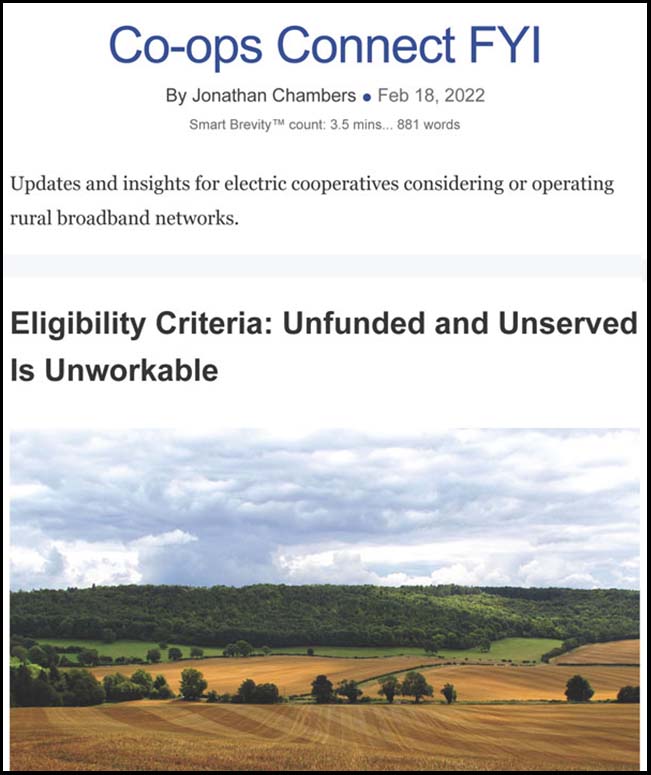Eligibility Criteria: Unfunded and Unserved Is Unworkable
February 18, 2022
The first step in establishing an efficient broadband infrastructure funding program: Start by mapping geographic areas eligible for funding by identifying unserved and partially served census blocks.
Be careful:
- There are those who would add an additional criterion for eligibility – areas that do not currently receive broadband funding.
- A group of Senators recently wrote the NTIA Administrator recommending NTIA ensure that Infrastructure Act funds “avoid projects in areas where reliable broadband is already being provided or where there is an enforceable commitment to build high-speed broadband using federal or state funds.”
- RUS’s ReConnect program prohibits grants to areas where they loan money to telephone companies.
- States are restricting ARPA funding to non-RDOF areas.
Does that make sense?
Last year, Conexon mapped this exact proposal, assuming money could not be allocated:
1. Where broadband is already provided, or
2. Where public money is already being spent.
- We used narrow definitions for broadband and for public funding to display as much of the country as possible, given these two constraints. (Using 25/3 Mbps or any other technology or transmission media would result in fewer eligible areas.)
- We assumed “reliable broadband” meant only fiber or cable broadband. This is a proxy for speeds of at least 100/20 Mbps. (If we had considered satellite or mobile to be “reliable broadband,” there would be no unserved areas.)
- We mapped only areas that receive funding from the FCC’s existing universal service broadband programs. (Adding all other federal and state programs would also result in fewer eligible areas.)
Why it matters: The results are striking.
Conexon’s interactive map of areas that are unserved with fiber or cable broadband and unfunded by FCC programs.
The bottom line: If funding is restricted to areas that are unserved and unfunded, few eligible areas remain.
Interpreting the Maps’ Meaning
- Go deeper: To show how it works, let’s look at screenshots of the country’s heartland, with Missouri at the center.
- First, this map shows the areas served with either cable or fiber broadband.
Why it matters: You can see that cable and fiber are predominantly in cities and populous areas: Kansas City, St. Louis, Nashville, Peoria, Tulsa, any area that has enough density to make the economics work for the cable and fiber industries. (An exception: you can see Co-Mo Connect’s fiber footprint in the center of the state of Missouri.)
- In general, the population density that supports cable or fiber has been approximately 20 homes per mile and greater.Second, we mapped out areas where the FCC spends funds on broadband, mostly through its Connect America Fund and Rural Digital Opportunity Fund programs.
- Again, this is a narrow definition for demonstration purposes.
We did not include other FCC programs that support broadband such as e-rate; other federal programs such as CARES Act, ARPA, or ReConnect; or state programs.
This map shows the areas covered by the FCC’s High Cost Funds in the same geography as shown above:
Surprised? You shouldn’t be. The FCC’s High Cost program funding is distributed through 16 active funds:
- Connect America Cost Model
- Connect America Fund Broadband Loop Support
- Alternative Connect America Model I
- Alternative Connect America Model II
- Frozen High Cost SupportConnect America Fund Intercarrier Compensation
- High Cost Loop Support
- Alaska Plan Support
- Rural Broadband Experiment
- Mobility Fund Phase I
- Uniendo a Puerto Rico Fund
- Connect USVI Fund mobile support
- Safety Net Additive
- Safety Valve Support
- Connect America Fund Phase II Auction
- Rural Digital Opportunity Fund
Want to see the data? The geographic areas, recipients and amounts spent by month are all public.
To quote James Thurber: “You could look it up.” All of the data is available here from the Universal Service Administrative Co.
A Closer Look
Third, we excluded unpopulated areas. This map shows funded, served, and unpopulated areas. The blank areas that remain are unserved and unfunded where populated.
To make the display clearer, these unfunded, unserved areas can also be shown in pink.
What does the rest of the country look like? Not much different from Missouri.
The Northeast
The SouthThe Great Plains
Why it matters:
The FCC High Cost programs include enforceable commitments to provide high speed broadband, as do the RUS ReConnect programs, NTIA broadband programs, CARES and ARPA programs administered by states and counties, and other programs too numerous to mention.
The bottom line: There is scarcely any populated area in the country that is unserved and unfunded.
If NTIA were to allocate funds only to areas that are unserved by reliable high-speed broadband and unfunded with an enforceable commitment to build broadband, it would be impossible to spend the $42.45 billion to be allocated to the states.
If states similarly limit funds, they will perpetuate the digital divide.
Final Thought
Big picture: The digital divide was created and perpetuated by the very programs meant to address the problem. These programs have:
Set standards already out of date before the money was spent.
Limited funds where they were needed.
Restricted so-called overbuilding.
The bottom line:
Bringing high-speed internet access to rural areas isn’t overbuilding, it’s building.
